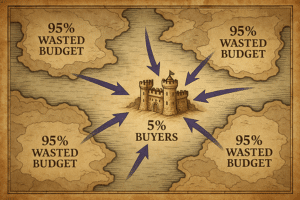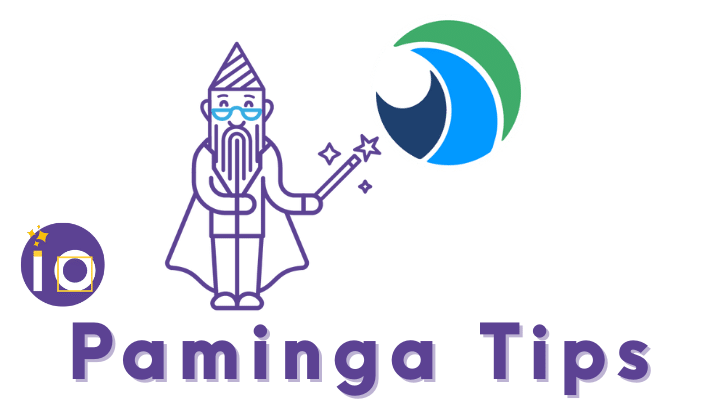At Merlin/Leonard, we rarely encounter companies that launch an ABx (Account-Based Experience) strategy by deploying a complete technology stack from day one.
They often start with a proof of concept (POC) to demonstrate the value of this approach before rolling it out more widely.
This article provides a detailed guide to getting started with your ABM POC at a low cost, while maximizing the impact on your strategic accounts.
Below is the Miro followed during this Marketing Office Hour
The features you need to make your ABx strategy a success
Before even talking about campaigns or messages, it’s essential to identify the minimum features required for effective ABM.
Here are the key features, inspired by the Miro table we used during our last Marketo Office Hour.
1️⃣ 🎯 Define your ICP (Ideal Customer Profile)
The ICP is the foundation of any ABM strategy. It defines the profile of the company most likely to buy your products or services—not in theory, but based on real data.
Without a solid ICP, everything else falls apart. It determines which accounts you should target, which signals to monitor, and what content to create.
A good ICP is based on three types of data, among others:
- Firmographics: size, sector, location, legal structure.
- Technographics: technologies used, competitor stack.
- Behavioral: past engagement level, purchase history.
What sets solutions apart
The most advanced solutions go beyond simple CRM segmentation.
They have a global database of companies, allowing you to enrich your own CRM.
One of the issues is the ability to reconcile your CRM accounts with those in the external database.
They use AI to detect similarities between your best-performing customers and accounts in your addressable market.
Examples of solutions
| Level | Main solutions |
|---|---|
| Lower market segment | HubSpot, Marketo (Smart Lists + firmo/techno filters via enrichment). |
| Middle market segment | ZoomInfo, Cognism, Clearbit (enrichment + technographics). |
| Top of market | Demandbase, 6sense (customer/market correlation AI). |
2️⃣ 🌐 Account detection and intent data
This involves identifying which accounts are “hot” in the market, even if they are not yet identified in your internal tools. Remember that at any given time, only 1 to 5% of accounts are actively searching.
One of the pillars of the ABx approach is to target ONLY these accounts.
Here, we will use solutions that leverage third-party data or solutions capable of identifying the IP addresses of people visiting your site.
Examples of solutions include Demandbase, 6sense, and Bombora, which collect signals of intent (searches, anonymous visits, etc.).
What sets these solutions apart
- Quality of the signal base : global coverage, geographic accuracy, granularity on topics that interest you.
- Signal intensity : ability to detect the number of searches per account and the recency of keyword searches.
- Integrated intent scoring : providing a ready-to-activate score, not just a list of keywords.
- History & trends : being able to compare an account’s evolution over time.
The differences also depend on the source of the data:
- 1st-party: what happens on your site (Marketo, Google Analytics).
- 2nd-party: review platforms (G2, TrustRadius, PeerSpot, Gartner Digital Markets).
- 3rd-party: publisher and aggregator networks (Bombora, Demandbase, TechTarget, 6sense).
Examples of solutions
| Level | Main solutions |
|---|---|
| Lower market | G2 Buyer Intent, TrustRadius Downstream Intent. |
| Mid-market | Bombora (Company Surge®), TechTarget Priority Engine. |
| High-end market | Demandbase Intent, 6sense Intent Data, Foundry (formerly IDG). |
Bonus: the most advanced solutions feature an “Account journey” that allows you to quickly position an account according to a maturity stage: “Awareness,” “Consideration,” or “Decision.”
This makes it possible to personalize actions on ads or web personalization engagement.
3️⃣ 👥 Account enrichment and buying group construction
To succeed with an ABx strategy, it is essential to have a complete view of the account: who are the right contacts? What is their role? What is the hierarchical structure?
You are no longer dealing with isolated leads, but with groups of decision-makers linked to the same account: IT, marketing, finance, senior management, etc.
This allows you to send the right message to the right person at the right time in the cycle.
The most advanced platforms can automatically recognize and segment roles within an account (buyer, influencer, sponsor, etc.).
This can be done upstream, to prepare a highly personalized approach (1:1 or 1:few), or after the first signals, to engage more finely with accounts detected in 1:many.
What makes the difference
- Richness and accuracy of the database: global or European coverage, depth of data (function, role, technologies used).
- Frequent updates: database updated regularly (even in real time).
- Ability to identify and structure the entire buying group, not just a few contacts.
- Seamless connection to CRM and marketing automation tools.
- GDPR compliance and legal compliance, essential in France and Europe.
Examples of solutions (French and European market)
| Level | Main solutions |
|---|---|
| Low end of the market | RocketReach, Kaspr, Lusha (basic version) — mainly for occasional searches or limited manual enrichment. |
| Mid-market | Cognism (strong presence in Europe and focus on GDPR), Dealfront (formerly Echobot, well established in DACH & France), ZoomInfo (but less coverage in France for specific contacts). |
| High end of the market | Dun & Bradstreet (Hoovers), LinkedIn Sales Insights (for structure and organization), Demandbase Data Cloud (integrated into the ABM suite), 6sense Data Enrichment — all capable of aligning buying groups and advanced firmographics. |
4️⃣ 🧩 Advanced account segmentation
You need to be able to create dynamic segments based on
- the profile (industry, size, technologies used)
- the behavior (pages visited, engagements),
- the intent data seen above,
- the complex relationships between your company and your customers (see the FIRE model in the new B2B Marketing Playbook)
- or the account progression in the “Journey”
Example: Smart Lists in Marketo or Demandbase’s Segmentation Engine.
These are the segments you will then send to different campaigns: personalized ads, marketing campaigns, or sales engagement campaigns.
What makes the difference
- Number of combinable criteria: firmographics, technographics, behavioral, intent signals.
- Multi-level capability: segmentation by accounts, buyer groups, and individuals.
- Dynamic segments: automatic updates based on new data.
- Precise management of exclusions and overlaps.
- Ability to filter based on lack of activity, opportunities, or responses to marketing actions
- Integration of external tables from your CRM or Marketing Automation (e.g., list of contracts, products purchased, internal support tickets, etc.)
Examples of solutions
| Level | Main solutions |
|---|---|
| Lower market segment | HubSpot ABM (basic), Freshsales, Pipedrive (simple ABM add-ons) |
| Middle market segment | Marketo Smart Lists, Salesforce Pardot (Account Segmentation), RollWorks |
| High end of the market | Demandbase One, 6sense Segmentation, Adobe Real-Time CDP B2B (very advanced on cross-channel segmentation) |
5️⃣ 🔄 Design and orchestrate journeys
This is where the strategy comes to life: at each stage of the journey, deliver the right message, at the right time, on the right channel.
And share the same vision of execution across marketing and sales.
You have a single funnel shared between marketing and sales, based on the progress of accounts in their purchasing journey.
What sets solutions apart
Advanced ABM platforms automatically manage triggers between systems: when an account moves from one stage to another, the CRM, Marketo, and sales are updated in real time.
Examples of solutions
| Level | Main solutions |
|---|---|
| Lower market | Manual CRM + Marketo workflows. |
| Mid-market | Make.com, Digibee, Tray.io, HubSpot Operations Hub |
| High-end market | Demandbase Orchestration Journey, 6sense Pipeline Progression. |
6️⃣ 📢 Targeted advertising activation
ABM ads allow you to reach your target accounts before they even visit your site.
This requires native integration with a DSP (Demand Side Platform) or ad integrations (e.g., LinkedIn Matched Audiences).
The best platforms link ad impressions to the account journey to measure actual marketing influence.
What makes the difference
- Number of channels supported: LinkedIn, display, native ads, retargeting, social ads, etc.
- Account-based retargeting capability (pure ABM retargeting).
- Frequency and budget management per account.
- Creative customization by segment.
Examples of solutions
| Level | Main solutions |
|---|---|
| Low end of the market | LinkedIn Campaign Manager (standalone), Meta Ads (via custom audiences) |
| Mid-market | RollWorks (ABM ads), Terminus, Metadata.io |
| High-end market | Demandbase Ads, 6sense Ads, Madison Logic (leader in multi-channel ABM advertising) |
7️⃣ 💻 Web personalization
Web personalization is the missing link between “I target” and “I convert.”
The goal is to display a different message, visual, or offer depending on the account or sector.
Your website becomes an extension of your ABM message.
What makes the difference
Number of possible variations (by segment or account).
- Ability to trigger in real time.
- Integration with analytics and multi-touch tracking.
- Integrated A/B or multivariate testing.
- Account detection based solely on cookies, or (as with Demandbase) on identified account data (IP, domain, cookie match).
Examples of solutions
| Level | Main solutions |
|---|---|
| Lower market segment | Google Optimize (recently closed but historical), Instapage Dynamic Text |
| Mid-market | Marketo Web Personalization, Dynamic Yield (standard) |
| High-end market | Adobe Target, Demandbase Web Personalization, Optimizely Full Stack |
8️⃣ ✉️ Marketing automation activation
Deploy email scenarios, workflows, or nurturing to support identified contacts in their purchasing cycle.
Traditional solutions: Marketo, HubSpot, Eloqua.
What makes the difference
- Content personalization by account.
- Cross-channel orchestration: emails, SMS, web, social.
- Level of CRM integration: fine synchronization, data enrichment.
- Native ABM scoring.
Examples of solutions
| Level | Main solutions |
|---|---|
| Low end of the market | Mailchimp (standard), Brevo (formerly Sendinblue), ActiveCampaign |
| Mid-market | HubSpot (with ABM add-on), Pardot (Account Engagement), Marketo (excluding ABM module) |
| High-end market | Marketo Engage + ABM module, Adobe Journey Optimizer, Salesforce Marketing Cloud Account Engagement |
9️⃣ 🤝 Sales activation
Align your sales teams so they can engage priority accounts as soon as the score is high enough.
Tools: Sales Insights in Marketo, Sales Navigator, or Sales Engagement tools (Outreach, Salesloft).
What makes the difference
- Automatic alerts based on intent or engagement signals.
- Deep integration with CRM and sales sequencer.
- Personalized “next best action” recommendations.
- Access to detailed insights on accounts and buyers.
Examples of solutions
| Level | Main solutions |
|---|---|
| Lower market segment | LinkedIn Sales Navigator (standalone), Outreach standalone, Yesware |
| Middle market segment | Salesloft, Outreach with enhancements, Marketo Sales Insight |
| High-end | Demandbase Sales Intelligence, 6sense for Sales, Groove (for sales enterprises ABM) |
🔟 📊 Measurement and ROI
Accurately track the impact of campaigns, from the first sign of intent to the revenue generated.
Solutions: Marketo dashboard, Demandbase dashboards, Adobe analytics.
What makes the difference
- Multi-touch and multi-channel view (advanced attribution).
- Granularity down to the individual account and buyer.
- Custom, cross-CRM, and marketing dashboards.
- Pipeline projection and revenue influence.
Examples of solutions
| Level | Main solutions |
|---|---|
| Low end of the market | Google Analytics (basic), HubSpot Analytics (starter) |
| Mid-range | Marketo Advanced Reports, Salesforce Tableau CRM, RollWorks Reporting |
| High end of the market | Adobe Customer Journey Analytics, 6sense Revenue AI, Bizible (Adobe), Demandbase Attribution |
1:1, 1:few or 1:many? Choosing your tactic
The choice between 1:1, 1:few and 1:many depends mainly on your resources and the size of your targets:
- 1:1: Ultra-personalized approach for a single strategic account. Requires a lot of resources, but potentially very high ROI.
- 1:few: Small segments (5 to 20 accounts) sharing the same need or profile. Good compromise between personalization and scalability.
- 1:many: Broad targeting (50+ accounts), more automated and less granular approach.
When starting an ABx strategy, it can be tempting to aim directly for 1:1 or 1:few, seduced by the idea of hyper-personalization and high impact on strategic accounts. But these approaches involve a lot of effort (personalization, sales-marketing coordination, dedicated resources) and present a high risk for a team that is not yet well-established.
✅ Step 1: Start with what you have → One to many
- Reuse your current campaigns and content.
- Target a large group of accounts that match your ICP.
- Test the ABx mechanics while controlling resources and budget.
✅ Step 2: Move to one to few
- Reduce the number of accounts targeted.
- Increase content personalization and sales collaboration.
- Introduce specific offers or more detailed journeys.
✅ Step 3: Move to one-to-one (if relevant)
- Focus on a few high-value accounts.
- Create fully customized experiences.
- Mobilize multiple internal functions (marketing, sales, CSM, management).
✔️ This way, you progress step by step, minimizing risk and giving your teams time to develop their skills.
Example of a classic “ABM-ized” campaign
Here’s how a traditional acquisition campaign can evolve into an ABM campaign, based on slides 1 and 2 of the Miro.
Traditional campaign (slide 1)
- Objective: Generate as many leads as possible, often through webinars or downloadable content.
- Metrics: Lead volume, conversion rate, cost per lead.
- Limitations: Many off-target contacts, low conversion rate into opportunities.
ABM-ized campaign (slide 2)
- Objective: Activate a small number of well-identified strategic accounts.
- Actions:
- Hyper-targeted ad campaigns on these accounts.
- Personalized email sequences enriched with intent signals.
- Web content tailored to these accounts.
- Close collaboration with sales reps to engage at the right time.
- Metrics: Engagement per account, progress in the buying cycle, pipeline generated.
- This pivot allows you to focus your efforts and budgets on the accounts that really matter—the ones that will generate the most value.
This pivot allows you to focus your efforts and budgets on the accounts that really matter—the ones that will generate the most value.
In conclusion: test before you go!
Launching an ABM proof of concept is a great way to demonstrate the value of an account-centric approach without immediately committing large budgets.
We recommend starting with a minimal foundation (Marketo + CRM + intent solution), adopting a 1:few strategy, then measuring and adjusting before scaling up.
🎁 And to help you along the way, take advantage of my free 1.5-hour strategic coaching session with me, Sylvain Davril, to challenge your marketing and identify your first ABM campaign.







